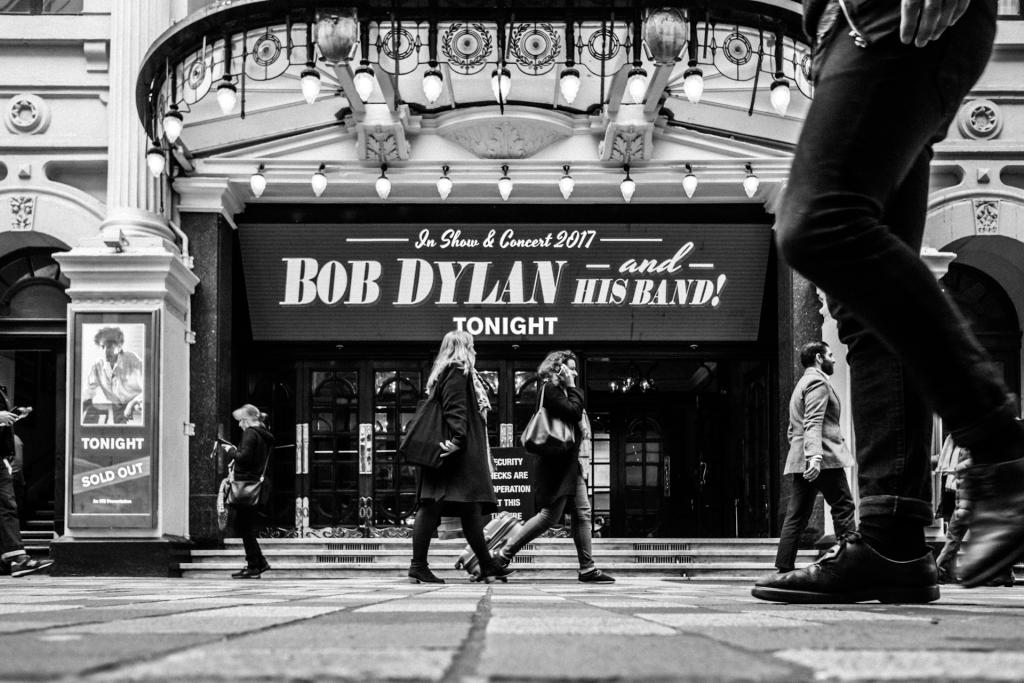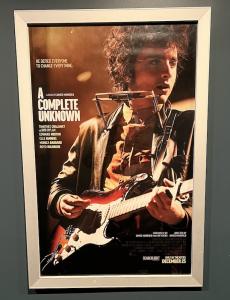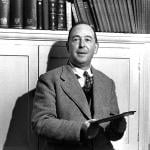
“Two hundred people in that room, and each one wants me to be somebody else. They should just let me be,” says Timothée Chalamet in his best Dylan enigmatic way, playing in his latest role as Bob Dylan in A Complete Unknown, which hit theaters on December 25, 2024. In this scene, Dylan longs to escape being used for his talents or exploited for causes that fail to recognize his individuality. Many of us can relate to such a statement, and such a statement will re-introduce Dylan to a new generation. In this depicted scene, Bob feels the pressures of those around him and resists conforming to the norms of the countercultural and music scenes – but also a society defined by emerging civil unrest that seemingly longs to dictate how he should fit into the world around him.
In A Complete Unknown, Timothée Chalamet creatively and brilliantly portrays Bob Dylan, though with little character development, capturing the essence of the legendary musician’s enigmatic earliest years in the music industry. Released on December 25, 2024, A Complete Unknown delves into Dylan’s rise to fame, exploring Dylan’s pressures of fame, his resistance to conformity, and the cultural upheaval of the 1960s. With powerful performances and a captivating storyline, A Complete Unknown offers both new and longtime Dylan fans a unique perspective on the folk icon’s journey, making it a must-see for anyone interested in music history and the countercultural movement. The true Dylan, however, remains a complete unknown even after watching this film.
The Film: A Complete Unknown
This film, released by James Mangold, focuses on the young Dylan who rolled into the countercultural, civil rights-focused folk scene of the northeast with mystery, brashness, and alarming creativity. The movie captures the essence of songs, performances, and cultural stories from 1961 to 1965, which is what built the stairway that Dylan took upwards to international stardom. While some events in the movie occur in different settings than depicted, many of them seem to accurately reflect the era and story, portraying not only the societal turmoil but also the reactions to Dylan and his electrifying presence.

Katie and I caught the 10:15 pm showing of Timothée Chalamet on Friday, December 27, at Reel Cinemas in Lancaster, Pennsylvania. We were mostly in an empty theater, minus five young individuals behind us. I went in with low expectations, I was not sure what to expect. Though some parts leaned more into creative interpretation than historical accuracy, the movie captivated me with its storytelling, depictions, and music. The actors played their roles and played their songs with the mystery, ticks, and oddities of the characters they portrayed. Dylan is part lore and overwhelmingly mysterious, Seeger is passionate and stuck, and Joan Baez (Monica Barbaro) captures the attention she did in that era. It reminded me of all of the reasons that I have always loved the countercultural and folk scenes. However, A Complete Unknown doesn’t explore the many facets and grandeur of details, nor does it truly capture the stories behind the songs. At the core of this movie, it is a biopic – a film that creatively dramatizes the life of a real person, captivating us with the context of the key events, challenges, or achievements – without going anywhere or giving us the whole or true story. I would have liked to see Sara Lownds (a different name in the movie) at least introduce Dylan to the passions and influence of the Civil Rights movement with more clarity.

I must also mention that Ed Norton delivers an outstanding performance as another one of my musical heroes, Pete Seeger (sang so many Seeger songs in protests in my youth). Seeger’s character nearly stood out as much as Dylan himself. One article described Seeger in this film as “preternaturally good-hearted, but also part booster, part handler, part jealous rival, part stubborn doctrinaire.” The truth is, I love Seeger, and I believe his role in creating a countercultural movement—one that would eventually lead to the hippie movement, Woodstock, and even the Jesus Revolution—is often overlooked and undermined. Seeger was a true blue believer in his cause, and he inspired more than he has been given credit for – a movement that seems lost but needed in a divided world like today. Norton’s character not only stands out for his prophetic hope that we can come together again, but in his acting as well as he learned to also perform Seeger’s classic songs in the movie, learning to play the banjo to accurately portray Seeger.
There were times in A Complete Unknown that I rightly disliked Dylan—his brash treatment of Joan, his inattentiveness to his first girlfriend in the Village, and the honor-defying electric performance at the Newport Folk Festival, just to name a few. It needs to be that way, and I am glad they did that well. At other times, I also saw the smirking kid who captivated me with a gift for musical poetry.
An Attempt to Capture the Uncapturable
In reality, Bob Dylan has always evaded being pinned down or fully understood – there’s a lingering mystery about him. Many people have tried to capture him in stories, movies, and books. No one had done it (though some like I’m Not There did it quite creatively). Sometimes, we wonder if Dylan even knows Dylan. For sure, with great mystery and intrigue, Bob Dylan has sold us his alter ego, or at least lived into it through perhaps his confusion quite well. As the actor portraying Dylan says in the movie, “If anyone’s gonna hold your attention on a stage, you have to kind of be a freak.” Over the years, Dylan has found a way to captivate minds and remain a mystery and yet remain on the forefront, unlike any other figure. The voice of a generation has become the voice of an era and many generations (Dylan is still belting out musical stories in his 80s). However, the movie isn’t exactly as it was. As Dylan has said, Timothée is a brilliant actor, even remarking, “I’m sure he’s going to be completely believable as me. Or a younger me. Or some other me,” in a post. The “or some other me,” might be closest but Chalamet truly embraces the role, learning the music rather than lip-syncing and mastering the legendary raspy vocals of Dylan for the film. In many ways, the thing Dylan avoided, trying to be a symbol, is exactly what this movie does to Dylan in the story of the Village in the Sixties.
My Encounter with Dylan
Though I was born long after Dylan’s many phases – from folk to electric to his Christian era – I first discovered him through his second studio album, The Freewheelin’ Bob Dylan, released on May 27, 1963. To be fair, I was born between the releases of Shot of Love and Infidels. However, even in elementary school, I was drawn to his prophetic and challenging commentary on civil rights, nuclear warfare, and more (thank you to the radio on the bus, the am radio in my room, and friends). By the time I started playing guitar in middle school, Dylan’s poetry captivated my mind, and his mysterious way of presenting and challenging the status quo had me hooked.
The Freewheelin’ Bob Dylan album sits at the heart of the storytelling in A Complete Unknown. This is the era that is portrayed with creativity and craft. This album for me, like for many others, was captivating with songs such as “Blowin’ in the Wind,” “Masters of War,” “A Hard Rain’s a-Gonna Fall,” “Bob Dylan’s Blues,” “Talkin’ World War III Blues,” and “Don’t Think Twice, It’s All Right.” I can confidently say this album remains one of my favorites. There is no other musician that I have stayed as loyal to in the forty-plus years I have had listening to music.
Over time, I explored all of Bob Dylan’s catalog, jumping both forward and backward through his discography. In fact, after spending several years in the Vineyard USA movement in my twenties, I developed a newfound appreciation for the Oh Mercy, Slow Train Coming, and Saved eras, resonating with them in ways I hadn’t before (and these vinyl records still stay within reach). Admittedly, one of my favorite Bob Dylan albums is one that came out during my lifetime – his thirty-second studio album, Modern Times. I feel this album has been largely overlooked by fans and critics, but its lyricism and riff-driven grooves keep it in regular rotation for me, often spinning in our household and my office at least once a month (and it is playing as I write this post). Though it seems uncharacteristic for Dylan to release a Christmas album, his 2009 Christmas in the Heart has surprisingly found its place in our family’s holiday traditions.
A Complete Unknown: What Was Perfect
What the movie did well was make me long to belong to that era—the music scene and the emerging countercultural ideas. I found myself wanting to live on the land with Pete Seeger and to artistically push back against the threats of an overreaching government in small, dimly lit, smoky New York basements. In my teens, there were still some folk and poetry circles around, and I remember sitting on the floor as poets spoke their truths, guitar players strummed songs they’d written about their fears, and questions were asked that made us think. There were finger snaps, hand-holding with beautiful strangers, and the hope that we were going to change something. That fueled my love for the later punk rock and hardcore scenes that I became part of. That hope and that way of thinking are much older than me, and this movie made me feel like a man out of time – who longed for a time that was not my own.
Faith in A Complete Unknown
I don’t have the space to unpack the beginning of Dylan’s faith journey as they played out in this movie, but I think the foundations were portrayed. Also, I am not a movie critiquer or critic. I am a pastor and spiritual pilgrim, living out a gritty, subversive street-level theology through incarnational practice – and I am a blogger who blogs on the Lead a Quiet Life blog on Patheos, exploring what it means to lead a quieter life at a slower pace, to discover a simple life and faith that embraces downward mobility in a chaotic world and church obsessed with excess. From that liminal space, let me tell you about the aspect of faith I took from A Complete Unknown.
In A Complete Unknown, Bob Dylan’s complex journey serves as a reminder that people are a mystery, shaped by layers of stories and experiences, both well-known and largely unknown to others and to ourselves at times. Bob Dylan’s resistance to being defined by others reflects the reality that we all carry brokenness within us—a brokenness that impacts those around us in ways we sometimes understand and sometimes do not. Bob’s broken story encourages us to seek healing and work through our inner struggles, not just for our own sake, but for the good of others as well. Dylan also points to the reality that some are born with extraordinary gifts and talents, but those gifts can sometimes lead to exploitation or jealousy from others. This reminds us to know the importance of our intentions as we relate to others—how we treat those around us, especially when they hold something we desire or admire. Pete Seeger in the film stands out as a figure who lives with purpose and is dedicated to justice, simplicity, and kingdom causes (though also human). Like Seeger, I want to be a person of simplicity and compassion, loving my neighbors well and doing good to others, minding my own business as much as I can. I long to create platforms for others to flourish and be their true, God-given selves. Johnny Cash’s character in the film resonates as a powerful reminder that the redeemed are also in need of redemption but also are part of the empowering of others’ redemption at the same time. And in the midst of it all, there are people like me —and like Dylan—searching for justice, peace, hope, and joy, trying to push back against societal forces and the expectations people have put on us. Our commonalities are inroads that share the possibility of sharing the goodness of God and the transformative power of the gospel with those longing for healing, purpose, and truth. Rather than retreating to our subcultures, we would do good to join the parties that are already happening around us with the Spirit’s power, and with the Thunder on the mountain.
Also, all of the characters in this story, from Woody to Seeger, from Cash to Dylan, reveal a deeper truth about our human condition: that we are all searching for something beyond ourselves, for meaning and connection in a divided and fractured world. None of us exist in isolation but are interwoven with others, their stories, and struggles. In this sense, Dylan’s journey is not just one of individual expression but also one of continual communal reflection and growth. The film shows how we must learn to navigate both our brokenness and the injustices around us while remaining open to redemption and transformation. I’d also note that these characters, despite their flaws and imperfections, serve as examples of people who—whether they fully realize it or not—are part of a greater story of grace and restoration, a restoration both Dylan and Cash will experience later in their journey.
In some ways, Dylan reminds me of Paul’s warning in Romans 12:2 to not conform to the pattern of this world. Or as James puts it, we are not to be polluted by the world around us (James 1:27). As a wayward pilgrim myself, I reflect on my journey through this movie, and I recognize that true answers are found only in Jesus’ invitation to the weary and burdened to find rest, as we see in Matthew 11:28-30.
Some Concluding Thoughts on A Complete Unknown
In the end, A Complete Unknown offers a creative and captivating biopic glimpse into the enigmatic world of Bob Dylan, a world that continues to captivate and mystify both his fans and somehow welcomes new fans into fandom alike. No, the film was not a full historical account, but it artistically illustrates and illuminates the essence of a raw era full of the untamed restless energy of a young Bob Dylan navigating the pressures of fame, identity, and societal expectations. Those of us who have never truly fit in will find some of ourselves in Timothée Chalamet’s portrayal and I am thankful for that. Again, Timothée Chalamet’s is a testament to Bob Dylan’s complex legacy, as he embodies the spirit of a man who has never been easily defined. For those familiar with Dylan’s music and message, the film serves as a reflective journey through his early years while offering a fresh perspective for a new generation. And while the movie may not unravel every layer of Dylan’s persona, it underscores the lasting mystery and impact of an artist who continues to be a voice of reflection for the ages. I echo Theologian Ben Witherington III who writes on his Patheos blog about the movie, “I hope this film gets some nods for best picture of the year, as it certainly deserves it.”
I’m always interested in a good conversation or a cup of coffee. Let’s connect! I love hearing others’ stories and sharing my own while finding ways to support others on their journey. Feel free to reach out to me via email —I’d love to hear from you. Online you can also connect with me through Facebook, Instagram, Bluesky, X, LinkedIn, Threads, TikTok, and YouTube.













